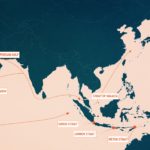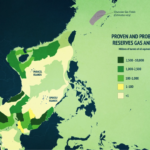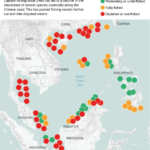Part I of this two-part blog post (available here) discussed the legal effects of findings by the Permanent Court of Arbitration (the Tribunal) in its South China Sea Arbitration award of July 2016. 1 In Part II, I will discuss the practical implications of those legal effects, with a particular focus on the shipping, energy, and fishing industries.
Shipping

To say that the South China Sea is an important trade corridor would be a vast understatement. It is the easiest route from China to markets in the West, over which more that $100 billion worth of goods passed from China to Africa in 2015,3 along with another $372 billion worth of goods to Europe.4 Additionally, a third of the world’s crude oil trade and half of the world’s liquefied natural gas trade travel through the South China Sea region,5 including 39 percent of China’s oil imports.6 Not only are these trade routes economically important, they are also vital to China’s current defense and military strategy, which is why China has been building islands to house military bases throughout the region.7
The findings of the Tribunal alter China’s ability to project power over the trade routes within the region in two key ways. First, by rejecting China’s claims to the nine-dash line, the Tribunal removed a potential argument by China that it had sovereignty over the areas in the South China Sea where it has engaged in island building.8 Second, the Tribunal—in addition to finding that none of the disputed features were “islands” within the meaning of the UN Convention on the Law of the Sea (UNCLOS)—reiterated the status of man-made islands, which are granted no maritime rights under the UNCLOS.9 This is significant because it means that unless they fall within the territorial sea or exclusive economic zone granted by another feature, China’s man-made islands are in the “high seas”, and afforded no rights or protections under the UNCLOS, and fully subject to overflight or freedom of navigation patrols.10
Oil and Gas

The most immediate and tangible effect of the Tribunal’s award on the oil and gas industry will be related to the shipping industry. The South China Sea is a vital corridor for the transportation of gas and oil resources and its protection holds strategic importance for the economies it feeds. Potentially overlooked, however, is the possibility of undiscovered oil and natural gas resources. In 2010, a U.S. Geological Survey estimated that up to 5.4 billion barrels of oil and 55 trillion cubic feet of natural gas lay undiscovered beneath the seabed of the South China Sea.12 Furthermore, even where oil resources are known and ready to be tapped, tension over ownership has caused confusion and slow-downs. For example, in 2012, the Chinese state-owned oil and gas exploration company CNOOC offered up for bid several off-shore exploration blocks lying within the exclusive economic zone of Vietnam.13 Some of these blocks had already been granted by Vietnam to international exploration companies such as Russia’s Gazprom and India’s ONGC Videsh Ltd., causing standoffs during which neither company was able to exploit the oil resources.14
The confusion surrounding competing claims should be largely settled with the Tribunal’s explicit rejection of the nine-dash line, on which all of China had based all of its ownership claims. As for the untapped resources potentially lying beneath the seabed, the limitation of maritime rights offer some certainty, at least in some regions, that possible reserves will not lie within the exclusive economic zone of any nation, making their exploitation available to other states. While this revelation, by itself, may not induce large-scale investment in energy exploration given other uncertainties, it could very well provide a basis for cooperation among the littoral states in creating a joint development zone.
Commercial Fishing

Commercial fishing is one of the most important industries to the littoral states of the South China Sea.16 In 2000, 11 million metric tons of fish were captured in the South China Sea, accounting for 10 percent of the world capture.17 The estimated value of the catch in 2012 was US$ 22 billion.18 In addition to being a big business within these states, commercial fishing also provides an important source of food for their populations. However, the wild catch in the South China Sea has steadily declined since the 1970’s as a result of overexploitation.19
With its clarification of the status of man-made islands and other features in the South China Sea, the Tribunal’s award makes clear that vast areas of the sea are not under the exclusive control of any state. Being in the “high seas”, fishing within these areas are subject only to the soft restriction that it be conducted with “due regard for the interests of the other States in their exercise of the freedom of the high seas.”20 Just as with the unexploited oil and gas resources beneath the seabed, the fisheries of the South China Sea must now be stewarded by the littoral states in cooperation with one another in order to avoid overexploitation, which would be disastrous for all the interested states.
Thomas Canny, Legal and Practical Effects of the South China Sea Arbitration Award, MBELR Online (Apr. 2, 2017), https://www.mbelr.org/legal-and-practical-effects-of-the-south-china-sea-arbitration-ruling-part-i-of-ii/. ↩
18 Maps That Explain Maritime Security in Asia, Asia Maritime Transparency Initiative, https://amti.csis.org/atlas/. ↩
Africa-China exports fall by 40% after China slowdown, BBC (Jan. 13, 2016), http://www.bbc.com/news/world-africa-35303981 ↩
European Commission Directorate-General for Trade, Report on Trade with China, http://ec.europa.eu/trade/policy/countries-and-regions/countries/china/. ↩
Factbox: South China Sea ruling – What’s at stake for oil, commodities?, S&P Global Platts (Jul. 22, 2016), http://www.platts.com/latest-news/oil/singapore/factbox-south-china-sea-ruling—whats-at-stake-27632115. ↩
18 Maps That Explain Maritime Security in Asia, Asia Maritime Transparency Initiative (2014), https://amti.csis.org/atlas/. ↩
Katie Hunt & Kathy Quiano, South China Sea: China Building more islands?, CNN (Sept. 8, 2016), http://www.cnn.com/2016/09/08/asia/south-china-sea-scarborough-shoal-philippines-china/. ↩
In re South China Sea Arb. (Philippines v. China), No. 2013-19 at 473 (Perm. Ct. of Arb. 2016), https://pca-cpa.org/wp-content/uploads/sites/175/2016/07/PH-CN-20160712-Award.pdf [hereinafter South China Sea Arbitration]. ↩
Id. at 219-20. ↩
Id. at 91. ↩
18 Maps That Explain Maritime Security in Asia, Asia Maritime Transparency Initiative, https://amti.csis.org/atlas/ ↩
U.S. Geological Survey, Assessment of Undiscovered Oil and Gas Resources of Southeast Asia (2010). ↩
See Song Yen Ling & Dao Dang, Tensions rise as China offers blocks in waters offshore Vietnam, S&P Global Platts (Jun. 29, 2012), http://www.platts.com/news-feature/2012/chinavietnam/index. ↩
Id. ↩
Conflict and Cooperation in the South China Sea, Stratfor (August 31, 2016), https://www.stratfor.com/analysis/conflict-and-cooperation-south-china-sea. ↩
See Allison Witter et al., Taking Stock and Projecting the Future of South China Sea Fisheries 2 (2015) (Listing the extent and importance of fisheries to the littoral nations of the South China Sea). ↩
See David Rosenberg, Fisheries Management in the South China Sea, in Security and International Politics in the South China Sea 61-62 (Sam Bateman & Ralf Emmers eds., 2009). ↩
Witter, supra note 15 at 15 ↩
Rosenberg, supra note 16 at 62. ↩
UNCLOS, Dec. 10 1982, art. 87(2), 1833 U.N.T.S. 397. ↩
